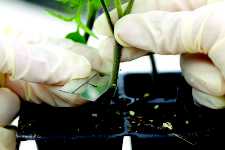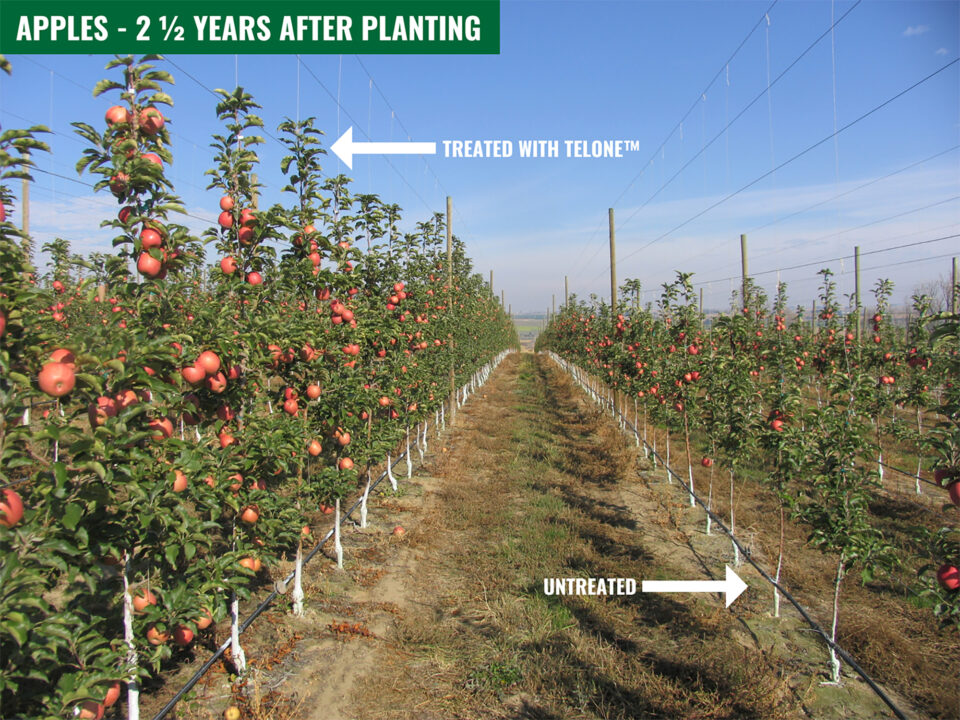Grafting Technology Can Limit Disease, Salinity, And Stress in Vegetable Crops

Editors Note: This is the first in a series of articles on grafting that will follow the progress of a group of researchers from several universities throughout the U.S. The funding for the research has been made possible from a grant from USDA with matching support from many industry partners.
This by no means marks the first time USDA and industry have opted to invest in grafting technology. In recent years, Ohio State University- and North Carolina State University-led teams received funding through USDA and USAID (United States Agency for International Development) to work on grafting issues in conventional and organic production. That and related work done by others has led to much of the home-grown Extension materials on grafting that are available today.
The education will continue. Be on the lookout for how-to grafting articles, which will include new grafting technology for tomato and cucurbit crops, the latest in automation, and more.
The Merriam-Webster Dictionary defines grafting as “the point of insertion of a scion upon a stock.” The process and the benefits that can be reaped by growers, however, go far beyond that simple explanation.
Grafting is a technology that has been around for hundreds of years and it is an established production practice in Europe and Asia on tomato and cucurbit crops. In this country, however, grafting has been less widely adopted in producing these crops.
Why the push to increase U.S. adoption of this technology? As those who have used grafted plants know, they can help limit losses due to disease, salinity, and other stress. Grafting has become important in crop management toolboxes. In addition, grafted plants themselves can be a commodity for suppliers. Overall, grafting may represent opportunity.
According to researchers, these plants can be stronger, healthier, and better equipped to fend off various stresses, biotic and environmental.
This, in turn, leads to increased yields and better overall production. In the end, it means higher profits for growers.
Thanks to the recently awarded grant, six universities, USDA, and corporate partners will work in tandem to shed light on how best to incorporate grafting into the toolbox of large and small growers and into the product line of suppliers.
American Vegetable Grower recently caught up with one of the members of the university-led grafting team, Matt Kleinhenz, an associate professor and Extension vegetable specialist at The Ohio State University, to find out more about the team’s goals and what the future may hold.
Q1 What are the advantages of using grafted plants to
both large and small vegetable growers?
Kleinhenz: Grafting is an important tool for vegetable growers because it has a proven capacity to help overcome some production challenges. It is also important because grafting is scale-neutral. A grower can use one or many thousands of grafted plants as a strategy to counteract different types of crop stress.
The process relies on employing a wider range of genetics efficiently. The rootstock root system has attributes that the root system of the scion — which produces the fruit taken to market — lacks.
Basically, grafting is organ transplantation. In crop production terms, grafting replaces an inferior root system with a superior one. Other advantages may follow but the most fundamental advantage of grafting comes from the combination of two varieties.
Normally, these combinations take generations and years to obtain. In grafting, the combination is instantaneous. Since grafting is organ transplantation, the trick, of course, is to obtain the benefits while avoiding the risks. Cleanliness, for example, is key throughout the grafting process.
Q2 Disease control has been mentioned as an example of a production challenge that can be overcome by grafting plants. What are some other solutions grafting can offer growers?
Kleinhenz: Grafting is designed to help reduce plant stress in abiotic and biotic forms. Abiotic stresses such as salinity, low fertility, drought and freezing temperatures, are environmental. The other form of stress, biotic, involves another organism. With grafting, in nearly all cases the organism is a pathogen or nematode. So basically we are talking about disease management. Most often it is a soilborne disease that is being targeted.
Q3 Cucumber, tomato, watermelon, and other melons have been the main crops grafted with a high rate of success. When will other crops be grafted with the same success rate?
Kleinhenz: In short, when information is available to support it and when the laws of supply and demand call for it. The advantages of grafting other vegetables and the methods for doing so will have to become clear. Specifically, using grafted plants to overcome production challenges will have to be superior to using other tactics.
An anecdote may be useful here. The story of the history of grafting says that it began as a way for poor farmers to create very large-fruited gourds in which rice could be stored. These farmers produced larger gourds with grafted plants than they could by any other means. The gourds were hollowed out and filled with rice. Bellies remained full. No one would suggest using grafting commercially for storage purposes today. But, many are evaluating grafting in comparison to the tools and tactics they now employ to deal with certain production challenges.
Q4 As mentioned earlier, grafting is an ancient technique. How has the process become more efficient?
Kleinhenz: Practice and study make perfect. In historical terms, vegetable grafting has been rigorously tested by many people under many circumstances for only a short time. A high level of intense scrutiny by many talented people leads to improvement. Also, each bit of knowledge gained is not simple addition, it can create exponential increases in performance if shared and implemented.
Q5 Why is hand grafting still the main way the process is handled in the U.S?
Kleinhenz: Hand grafting is still the norm in the U.S. and in many other areas. There is no one answer as to “why” but the most often cited one is that hand grafting works and is appropriate for many circumstances. That said, automated grafting is on the rise and is a significant part of the future.
Grafting should not necessarily be thought of as done only by hand or machine. More than likely, when the largest possible number of grafted plants is needed, the process will involve man and machine. But, to be clear, companies in Europe and Asia routinely produce millions of grafted plants by hand each year. That capacity is developing in the U.S. Improvements in all aspects of the grafting process will be market driven.
Q6 Grafting automation, in terms of robotics and developments in Japan and other countries, continues to develop. What are the barriers and opportunities to greater automation in the U.S.?
Kleinhenz: Automated grafting is less prominent in the U.S. than elsewhere. Barriers appear to be primarily business-related. The prevalence of grafted plants produced using automated approaches will increase as the market for grafted plants increases and the efficiency and reliability with which they can be produced using automated approaches increases.
Q7 What are the grafting team’s future plans to help increase the market for grafted plants?
Kleinhenz: What we can do as a team is provide information on both ends of the spectrum. On the production side of grafted plants, we can continue to optimize and demonstrate ways in which grafted plants can be made
and distributed, both involving people and equipment.
On the consumption side, we can provide information that illustrates why growers would want to use grafted plants. We can tell them exactly what a grafted plant can do for them that a standard, ungrafted plant usually cannot.
The overall goal is to increase the information base so growers can make informed choices. The assumptions are that more and more people will be convinced that grafted plants have a role in their operation and that the market will climb as it has in other parts of the world.
Enhancing Techniques
According to Matt Kleinhenz, an associate professor and Extension vegetable specialist at The Ohio State University, the obvious goal of the grafting team is to enhance the success of U.S. fruiting vegetable industries by integrating grafting technologies into them.
“This is a coordinated team effort covering the waterfront of grafting issues,” he says. “Stakeholders and team members set the agenda. All are interested in grafting because its greater use stands to help farmers and other businesses.“
It will require objective evaluation, testing, and thorough communication for the entire process to work, he continues, encouraging anyone interested in vegetable grafting to contact a project team member at The Ohio State University, North Carolina State University, Virginia Tech University, Clemson University, University of Florida, University of Arizona, and USDA.
“Still, it is clear that most vegetable growers in the U.S. are near someone familiar with vegetable grafting,” he says. “In fact, vegetable grafting has been explored and discussed in at least 25 states.”
Greenhouse Growers Capitalize On Grafting
Some greenhouse producers have already figured out that even in optimal growing conditions, such as the greenhouse, grafted plants can give them “one up” on the competition, with their grafted plants out-yielding the ungrafted ones.
“These growers discovered that they can make better use of their square footage with grafted plants, partly because rootstocks of grafted plants are so vigorous and efficient,” explains Matt Kleinhenz, an associate professor and Extension vegetable specialist at The Ohio State University.
“As a result, grafting caught on rapidly in the greenhouse sector,” he says. “The same appears to be happening in the high tunnel sector where growers are also interested in potentially overnight increases in yield.”
To date, though, Kleinhenz says adoption has been slower in open field production, but the situation can change quickly.
“Experienced growers recall many examples of practices that were initially regarded as ‘fringe’ but are now mainstream,” he explains. “The use of grafted vegetable plants in high tunnels and fields may be the next one.”










